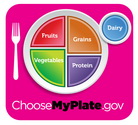|
Dietary Guidelines For Making Healthy Food Choices
Dietary guidelines provide information about food choices, food safety, and physical activity for people aged 2 years and over. The U.S. Department of Agriculture and the U.S. Department of Health and Human Services jointly produce dietary guidelines that are updated and released every 5 years based on the current scientific information. The revised guidelines for 2010 provide strategies through recommendations that address the food preferences, cultural traditions, and customs of the many diverse groups that live in the U.S.
These guidelines generally have been intended for healthy Americans but were released amid concerns that being overweight and obesity is reaching epidemic proportions in the U.S. due to poor diet and lack of physical activity of the American population, leading to an increase in overweight and obese Americans in turn leading to an increase in chronic diseases.
Statistics indicate that 72% of men, 64% of women, approximately 32% of children and adolescents aged 2 to 19 years are overweight or obese. There are basic areas for the 2010 dietary guidelines which are: • Balancing Calories To Manage Weight
• Foods And Food Components To Reduce • Foods And Nutrients To Increase • Building Healthy Eating Patterns The key recommendations paraphrased for each of these dietary guidelines are: Balancing Calories To Manage Weight • Develop behaviors to prevent and/or reduce being overweight and obesity through improved eating and physical activity. • To manage body weight consuming fewer calories from foods and beverages for those that are overweight or obese. • Reduce time spend in sedentary behaviors through increased physical activity.
• Through each stage of life; childhood, adolescence, adulthood, pregnancy, breastfeeding, and older age maintain appropriate caloric balance. Foods And Food Components To Reduce • Reduction of sodium intake to less than 2,300 milligrams (mg) and for those who are 51 years and older reduce the intake to 1,500 mg and this reduction applies to those with hypertension, diabetes, chronic kidney disease and who are African American.
• Replace saturated fatty acids with monounsaturated and polyunsaturated fatty acids to consume less than 10% of calories from saturated fatty acids. • For dietary cholesterol consume less than 300 mg per day.
• Limit foods that contain synthetic sources of trans fats, such as partially hydrogenated oils, and by limiting other solid fats to keep trans fatty acid consumption as low as possible. • Reduce caloric intake from added sugars and solid fats. • Limit consumption of foods that contain refined grains, especially refined grains that contain solid fats, added sugars, and sodium.
• Alcohol if consumed should be consumed in moderation, with one drink per day and no more for women and two drinks per day for men, and the adults should be of legal drinking age.
Foods And Nutrients To Increase As part of a healthy eating pattern while staying within an individual’s caloric needs the following recommendations should be met. • Increase the intake of fruits and vegetables • Eat a variety of vegetables, such as dark-green, red and orange vegetables, and beans and peas.
• At least half of all grains consumed should be whole grains. Replace refined grains with whole grains to increase whole grain intake. • The intake of fat-free or low fat milk, and milk products such as milk, yogurt, cheese or fortified soy beverages should be increased. • A variety of protein foods, including seafood, lean meat, poultry, eggs, beans, peas, soy products, and unsalted nuts and seeds should be chosen.
• The amount and variety of seafood should be increased by consuming seafood in place of some meat and poultry. • Protein foods that are higher in solid fats should be replaced with choices that are lower in solid fats and calories and/or are sources of oils. • Replace solid fats with oils where possible. • Foods should be chosen that provide more potassium, dietary fiber, calcium, and vitamin D. These are nutrients that are of concern in American diets. These foods include fruits, vegetables, whole grains, milk and milk products. Building Healthy Eating Patterns • The eating pattern selected should meet nutrient needs over times at an appropriate caloric level.
• All food and beverages consumed should be accounted for and assessed as to how they fit within a total healthy eating pattern.
• Food Safety recommendations should be followed when preparing and eating foods to reduce the risk of foodborne illnesses. There are additional recommendations for specific population groups Women Of Child Bearing Years • Foods should be chosen that supply iron in the heme form since it is more readily absorbed by the body.
• Synthetic folic acid should be consumed at the level of 400 micrograms (mcg) per day, in addition to folic acid from the diet. Pregnant Or Nursing Or Breast Feeding • Should consume 8-12 ounces (oz) of seafood per week from a variety of seafood types. • The following types of fish should not be eaten: tilefish, shark, swordfish, and king mackerel as well as albacore tuna due to high mercury content which should be limited to 6 oz per week. • An iron supplement should be taken as recommended by an obstetrician or other health care provider. Persons Ages 50 Years And Older • Foods fortified with vitamin B12, such as fortified cereals or dietary supplements. These dietary guidelines also recognize that in recent years almost 15% of Americans are unable to obtain adequate food to meet their nutritional needs. These guidelines can help these households to maximize the nutritional content of the meals that they are able to provide in order to provide a nutritionally adequate diet. For other information on nutrition including dietary guidelines some great references are: • Nutrition – Fourth Edition by Paul Insel, Don Ross, Kimberley McMahon, and Melissa Bernstein
Cooking Recipes
|







